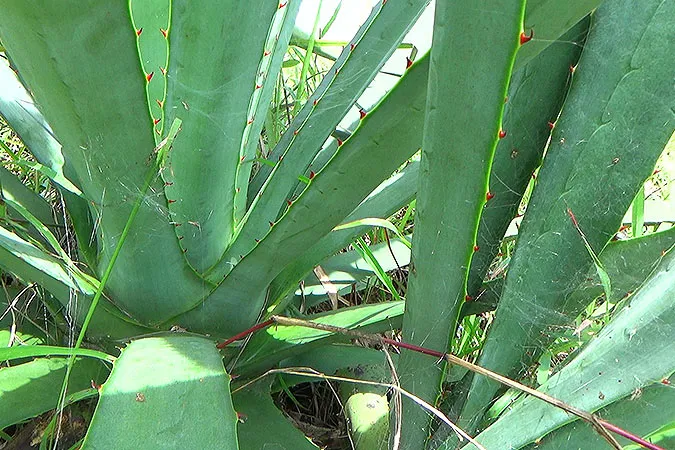Sabrang (Agave cantala) is a plant species in Asparagaceae, evergreen, succulent, xerophilic, monocarpic, perennial plant forming a rosette of leaves that can be up to 1.5 meters long, large thorns, growing wild on marginal land and towards the end of life plant puts up a flowering stem up to 8 meters tall.
A. cantala has grayish-green or bluish-gray leaves with a thicker base, the tip becomes pointed and black. Margins grow large spines, sharp, curved up to 3 cm and black. Each tree has 57 leaves.
Young and mature leaves have a length of 133 cm, width of 10 cm, thickness at the base of 16 mm, thickness at the edge of 2.27 mm, weight 400g, juice 22% and fiber yield of 3.40%. Old leaves have a yellowish green color, lose all thorns and slowly turn brown to dry.
The bisexual flower has a stem up to 8 meters long, sitting on a short twig, crammed tightly, a funnel-shaped tent tube for 1 cm. The header has a length of 2 cm, the inward part is narrow. The length of the stalk and pistil is 3 cm. Button-shaped pistil heads and three headers each.
Fruit buds are round, cylindrical and each chamber contains many seeds. Square fruit with a length of 4 cm. Pollination is aided by insects, birds and bats with different levels of efficiency. Generative and vegetative breeding.
Generative breeding produces many seeds, but only blooms once during the life phase. Vegetative propagation uses rhizomes and bulbil which grow and spread until new shoots emerge from the apical meristem. Rhizomes will remain attached to the parent plant until finally ready to separate and form new individuals.
Sabrang grows wild on calcareous hillside, dry land and dry climate, humidity 70-80%, full sun, rain cut 1,000-1,250 mm / year, temperature 9-41C, altitude up to 2,400 m, clay sandy, pH 5.5-7.5 and can't stand standing water.
A. cantala is cultivated for fiber where each leaf obtained through a mechanical process uses a decorticator to obtain wet fibers, then is dried for further processing. The fiber has a length of 4.19 mm, a width of 24.03 μm, a lumen diameter of 11.48 μm and a cell wall thickness of 6.28 μm.
Fiber contains 64-71% α-cellulose, 7-17% lignin, 12% hemicellulose, and 1-2% ash with mechanical and physical properties for density 800-700 kg / m3, water absorption 56%, tensile strength 268 MPa, modulus of elasticity is 15 Gpa. Salt resistant fiber and widely used for boat ropes.
Kingdom: Plantae
Phylum: Tracheophyta
Subphylum: Angiospermae
Class: Liliopsida
Order: Asparagales
Family: Asparagaceae
Subfamily: Agavoideae
Genus: Agave
Species: Agave cantala
Subspecies: Agave cantala var. acuispina and Agave cantala var. cantala
A. cantala has grayish-green or bluish-gray leaves with a thicker base, the tip becomes pointed and black. Margins grow large spines, sharp, curved up to 3 cm and black. Each tree has 57 leaves.
Young and mature leaves have a length of 133 cm, width of 10 cm, thickness at the base of 16 mm, thickness at the edge of 2.27 mm, weight 400g, juice 22% and fiber yield of 3.40%. Old leaves have a yellowish green color, lose all thorns and slowly turn brown to dry.
The bisexual flower has a stem up to 8 meters long, sitting on a short twig, crammed tightly, a funnel-shaped tent tube for 1 cm. The header has a length of 2 cm, the inward part is narrow. The length of the stalk and pistil is 3 cm. Button-shaped pistil heads and three headers each.
Fruit buds are round, cylindrical and each chamber contains many seeds. Square fruit with a length of 4 cm. Pollination is aided by insects, birds and bats with different levels of efficiency. Generative and vegetative breeding.
Generative breeding produces many seeds, but only blooms once during the life phase. Vegetative propagation uses rhizomes and bulbil which grow and spread until new shoots emerge from the apical meristem. Rhizomes will remain attached to the parent plant until finally ready to separate and form new individuals.
Sabrang grows wild on calcareous hillside, dry land and dry climate, humidity 70-80%, full sun, rain cut 1,000-1,250 mm / year, temperature 9-41C, altitude up to 2,400 m, clay sandy, pH 5.5-7.5 and can't stand standing water.
A. cantala is cultivated for fiber where each leaf obtained through a mechanical process uses a decorticator to obtain wet fibers, then is dried for further processing. The fiber has a length of 4.19 mm, a width of 24.03 μm, a lumen diameter of 11.48 μm and a cell wall thickness of 6.28 μm.
Fiber contains 64-71% α-cellulose, 7-17% lignin, 12% hemicellulose, and 1-2% ash with mechanical and physical properties for density 800-700 kg / m3, water absorption 56%, tensile strength 268 MPa, modulus of elasticity is 15 Gpa. Salt resistant fiber and widely used for boat ropes.
Kingdom: Plantae
Phylum: Tracheophyta
Subphylum: Angiospermae
Class: Liliopsida
Order: Asparagales
Family: Asparagaceae
Subfamily: Agavoideae
Genus: Agave
Species: Agave cantala
Subspecies: Agave cantala var. acuispina and Agave cantala var. cantala
